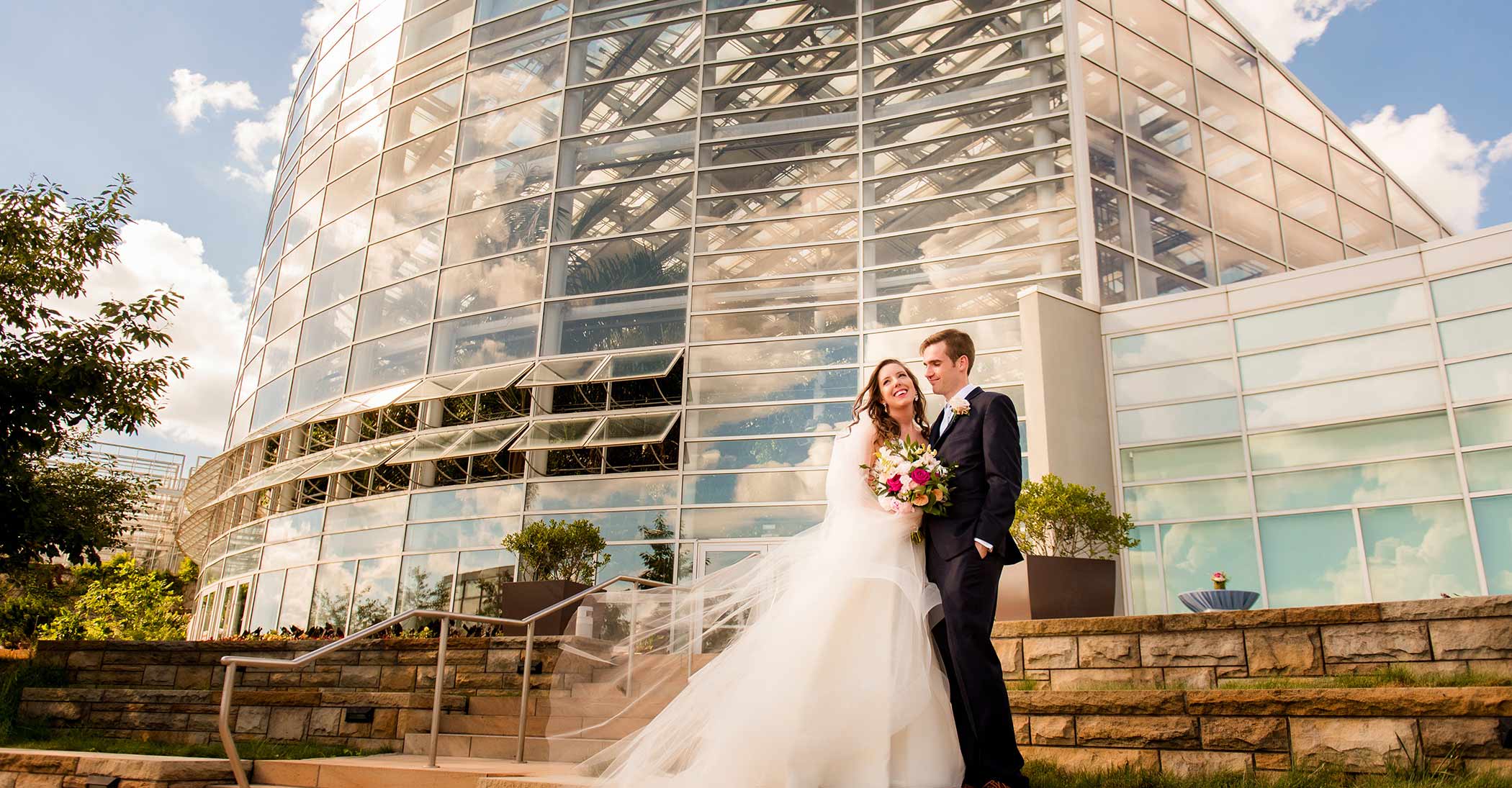Your Guide to a Gorgeous Green Wedding
1.jpg)
Photo above © Anne Louise Photography; Header photo © Leeann Marie Photography

When it comes to planning your special day, there are so many details to consider that the impact on the environment may not come into the conversation. That’s why a team of experts at Phipps compiled this easy guide of steps you can take to elevate the wedding of your dreams. Read on to learn more!
1. Location, Location, Location
Photo © Lee Ann Marie Photography
Choose a wedding venue that shares your eco-minded values. A venue that highlights the beauty of nature provides a stunning backdrop for you to tie the knot while reducing your carbon footprint.

One of the most inspiring aspects of weddings is that they symbolize the hope and promise of new beginnings. While they acknowledge the couple’s past and the paths that led them to that moment, they are a celebration of a future that will be all the brighter because they are together. Similarly, Phipps inspires guests through the beauty of stunning Victoria-era glass houses and floral displays. But Phipps also inspires with the promise of a bright and equitable future for all through sustainable practices and newer buildings that are some of the greenest in the world. They are beautiful, engaging spaces that are healthy for people and the ecosystems in which they are nested. While we do face challenges that can seem overwhelming, like climate change, Phipps demonstrates that together, we can discover the beauty of living in harmony with each other and the natural world.
— Adam Haas, Interpretive Program Manager
Steps You Can Take
- Look Before You Book. Research your venue before booking to ensure it uses responsible energy and supports initiatives that align with your values.
- Take It Outside. Alternatively, have an outdoor wedding. Getting married in a garden, at the beach or even in your backyard uses natural light, eliminating the environmental impact associated with many buildings and their operations.
Dig Deeper
Learn more about Phipps’ sustainable initiatives and commitment:
2. Plan Your Plate
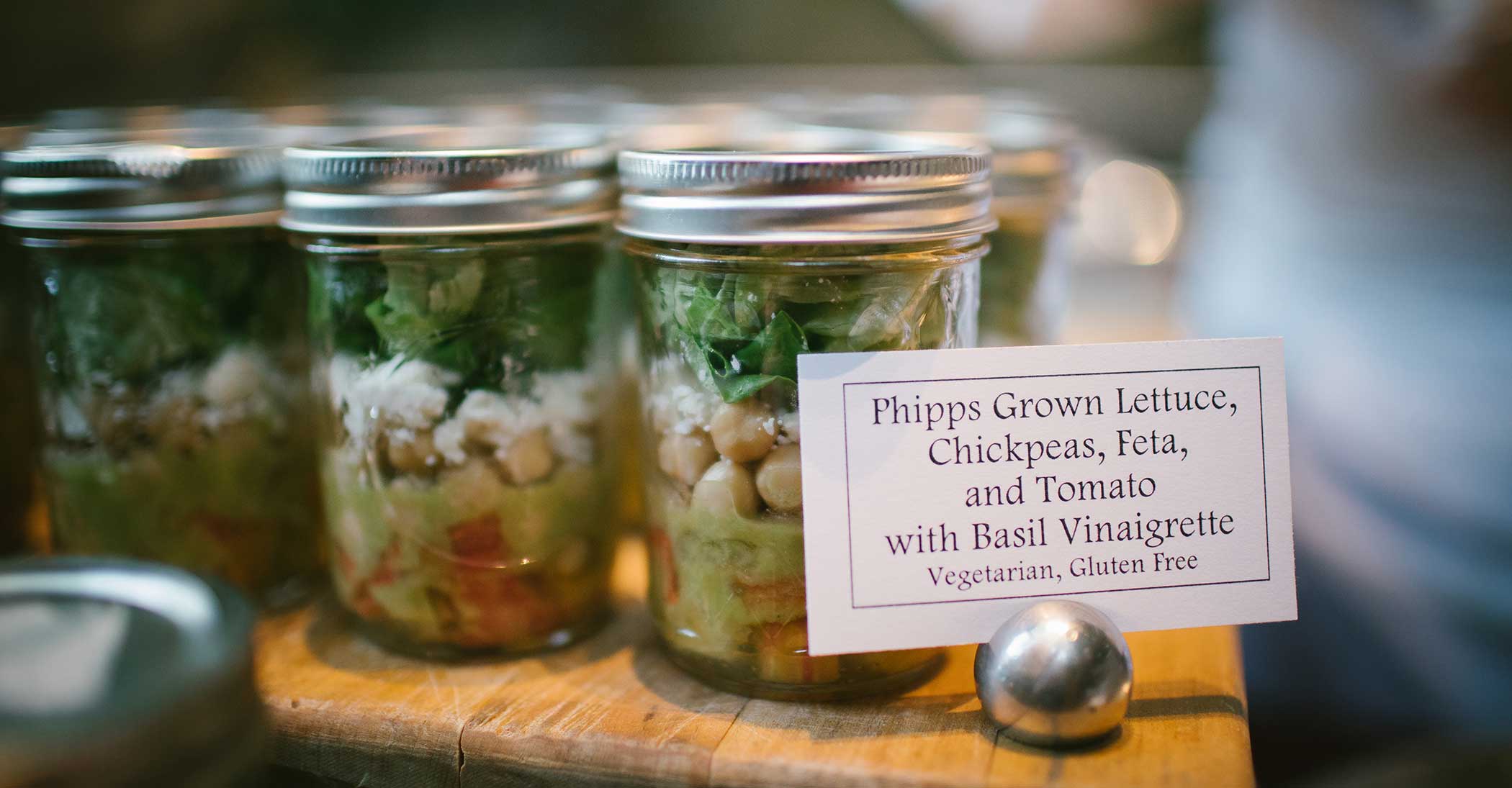
Photo © Jessica Lee Photography
One of the most impactful steps you can take to have an environmentally-friendly wedding is to carefully select your menu items. Choosing locally-sourced, organic food ensures that your guests will enjoy fresh, flavorful and delicious bites that eliminate or limit harm to the planet on their way to your plate.

Food is already one of the most important factors when planning an event, so factoring in sustainability can seem overwhelming. At Phipps, we make it easy by partnering with local caterers in the surrounding communities who meet our strict sustainability standards. Choosing a plant-forward menu—one that prioritizes fruits, vegetables, and grains—with limited animal products is a great place to start in reducing your wedding’s carbon footprint. For example, you can replace beef steak with a grilled cauliflower steak to give your guests a decadent dinner that’s good for them and the planet. It’s also important to know where your food is coming from. Does your caterer source locally? Is your menu organic? Does your caterer take waste into account when preparing and serving food? All of these aspects of food service can take your green wedding from ordinary to extraordinary!
— Lauren Ranalli, Event Sales Supervisor
Steps You Can Take
- Raise the Bar. Use a catering service with standards as high as your own. Choose an organization that has received green certifications — Café Phipps is proud to be a 3-star Green Restaurant Certified eating establishment, a Platinum designated Sustainable Pittsburgh Restaurant, a Farm Forward Leadership Circle Member, a Live Well Allegheny Restaurant and a Hobart Center for Foodservice Sustainability award winner. Don’t be afraid to ask how your catering service's food is sourced and choose an organization that sources mainly from local farms.
- Veg Out. Embrace a plant-rich menu. Fresh fruits, vegetables and spices add delicious flavor to any dish and can make for some truly mouthwatering plates while emitting a fraction of the greenhouse gases produced by meat farms.
- Make Smarter Meat Selections. Not all meats are created equal: According to a study by the Environmental Working Group, one kilogram of beef creates 27 kilograms of carbon dioxide, while one kilogram of chicken only creates 6.9 kilograms. Opt for chicken, turkey or fish, and be sure to choose humanely raised meat and sustainably caught fish.
- Choose Sustainable Spirits. From the way the alcohol is produced to the packaging it comes in, there are many environmental issues to consider when selecting your bar package. Ask your catering service to select organic, eco-conscious alcohol (Phipps offers a green bar package), or source yourself.
Dig Deeper
Find helpful resources and learn more about the environmental impact of your menu:
Sustainable Restaurant Finder | Sustainable Pittsburgh Restaurant
Climate Change Food Calculator: What’s Your Diet’s Carbon Footprint? | BBC News
That’s the Spirit: A Guide to Sustainable Liquor | Grist
Seafood Watch | Monterey Bay Aquarium
16 Delicious Vegan Options to Serve at Your Reception | The Knot
Avoiding Meat and Dairy is ‘Single Biggest Way’ to Reduce Your Impact on Earth | The Guardian
How Does Meat in the Diet Take an Environmental Toll? | Scientific American
Evaluating the Environmental Impacts of Dietary Recommendations | Proceedings of the National Academy of Sciences of the United States of America
Meat Eater’s Guide to Climate Change and Health | Environmental Working Group
3. Waste Not, Want Not
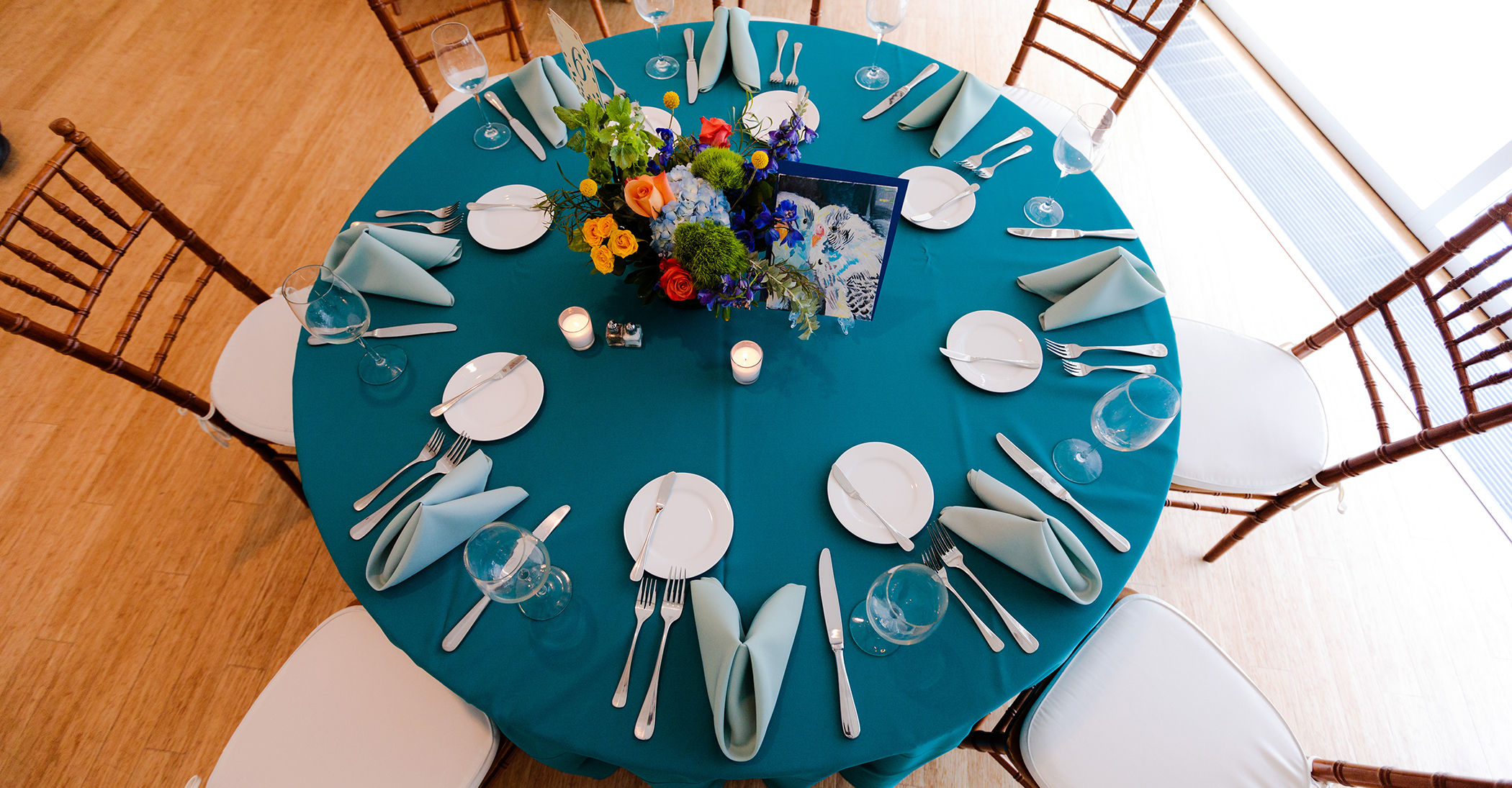
Photo © Kristen Vota Photography
Bring your waste full circle — by composting and recycling as much as possible, you’ll keep leftover material out of a landfill and instead put it to use to create beautiful materials for people to enjoy in the future.

At Phipps, we strive to reduce, recycle and compost wherever possible, and I love how much we teach our guests and colleagues about waste reduction as well. Say no to single-use disposable anything. If your family and friends cannot take leftover food, donate it to people in need through 412 Food Rescue. If you choose to have your special event at Phipps, you can rest assured that your food scraps will go to AgRecycle – a local organization that turns food waste into a nutrient-rich, healthy soil that our local communities can use and that our horticulture staff uses throughout the conservatory and outdoor gardens.
— Michelle Allworth, Facilities Project Manager
Steps You Can Take
- Watch the Scale. When ordering your catering package, remember that this is not the last meal your guests will ever eat. You can reduce waste by ordering proportionally. It will save you money and keep delicious food from going uneaten.
- Give Your Leftovers Some Love. Compost and recycle as much as possible — especially food waste. Set up and label multiple bins at the reception to allow your guests to easily dispose of their food scraps in a responsible way. Talk to your catering company to ensure the leftover food will be kept out of landfills. If the company’s policy doesn’t include composting, inquire about donating your leftovers to a local food bank.
- Keep It Real. Use dinnerware and silverware. Using real plates, glasses and silverware looks elegant and reduces your reliance on single-use plastic.
- Petal Power. Replace confetti or bits of paper with biodegradable items. Consider dried leaves, herbs or flowers that fit your wedding color palette. The photos will be stunning!
Dig Deeper
Explore more ideas to reduce waste and begin composting at home:
Donate Food | 412 Food Rescue
6 Ways to Reduce Food Waste at a Wedding | Food 52
6 Smart Ways to Reduce Waste at Your Wedding | Martha Stewart
8 Simple Ways to Make Your Wedding Less Wasteful | Huffington Post
Creative (and Eco-Friendly!) Wedding-Exit Toss Ideas | Brides
Composting at Home | United States Environmental Protection Agency
Reducing the Impact of Wasted Food by Feeding the Soil and Composting | United States Environmental Protection Agency
4. Creative Correspondences
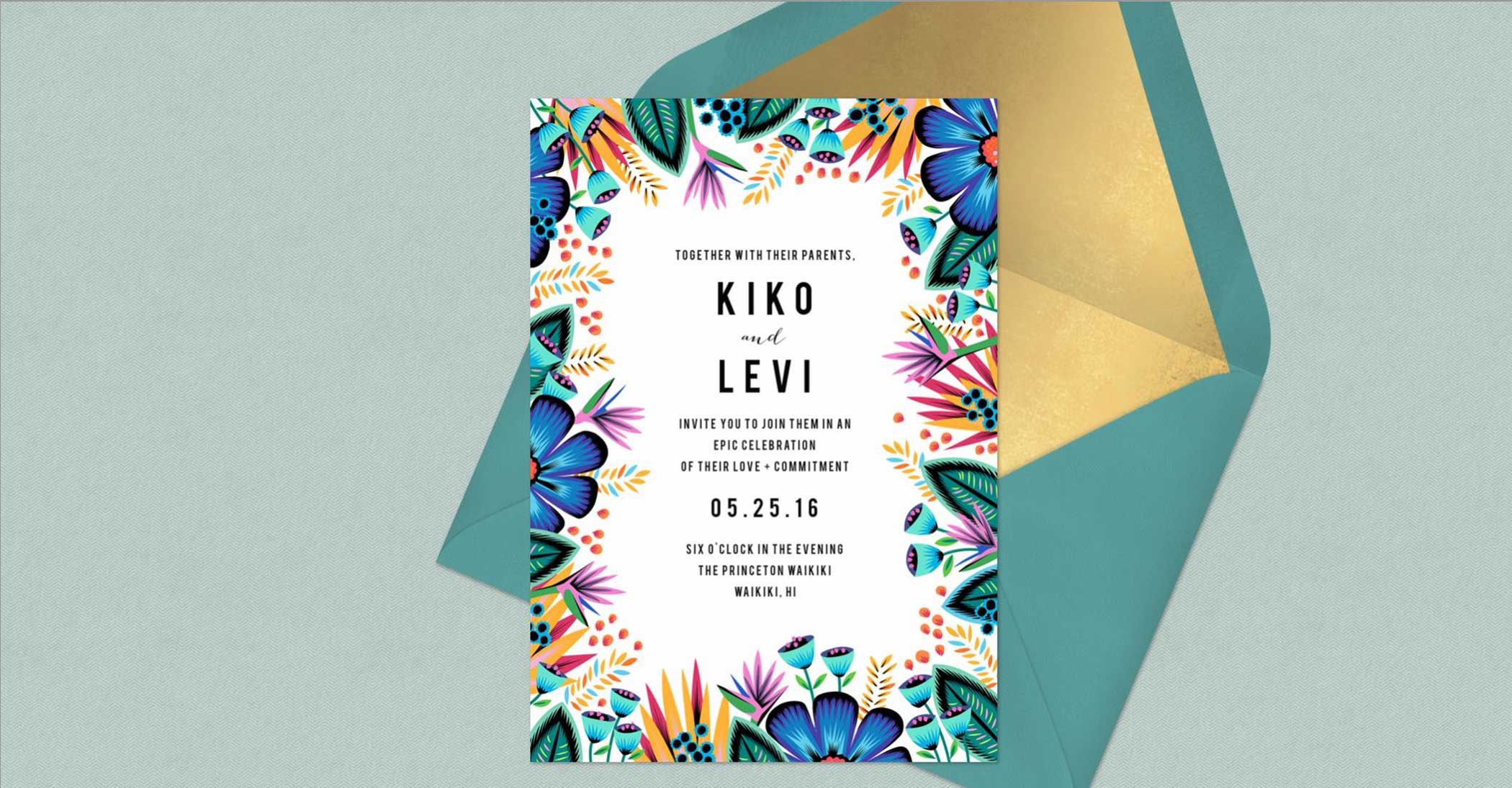
Photo © Greenvelope.com
Reducing your paper use helps the earth and saves you time, energy and money! Digital alternatives can make wedding planning quicker, easier and greener all at the same time.

As the world continues to go digital, now is the time to cast aside paper invitations in your wedding planning! Digital invitations are fully customizable, helpful in managing guest lists and, of course, a more sustainable option. Websites like Greenvelope allow you to create your dream one-of-a-kind invitation with convenient R.S.V.P. tracking. Digital invitations take paper invitations a step further by offering the ability to send reminders, collect dietary restrictions and stay connected with guests for any last-minute updates. If you're set on a traditional invitation, look into utilizing recycled paper and plant-based inks to reduce waste!
— Alexa Sinatra, Communications Coordinator
Steps You Can Take
- Go Tree Free. Particularly for invitations to the bridal shower, engagement party, bachelor/ette party and rehearsal dinner, opt for an e-vite. You will save money, paper, emissions from transportation and hand cramps!
- Choose Planet-Friendly Paper. Make sure you use 100% recycled paper and plant-based inks for any printed invitations. Paper Culture uses 100% recycled paper, offsets their carbon emissions and plants a tree for every order! Alternatively, try a seeded paper that guests can plant in their garden to grow flowers that will always remind them of your special day.
- Take a Pass on Paper. For items such as escort-cards, table numbers and more, eliminate the paper altogether and add a note of whimsy to the décor! For example, write table numbers on potted plants that can double as your centerpieces and use washable chalk markers so guests can take these pieces home to enjoy.
Dig Deeper
Discover digital alternatives, eco-friendly paper and additional tips:
Features | Greenvelope
Why Paper Culture? | Paper Culture
Eco-Friendly Tips and Tricks for Wedding Invitations | The Knot
Our Eco Commitment | Botanical Paperworks
An Eco-Friendly Guide to Wedding Invitations and Stationary | Martha Stewart Weddings
5. Give (and Receive) Green
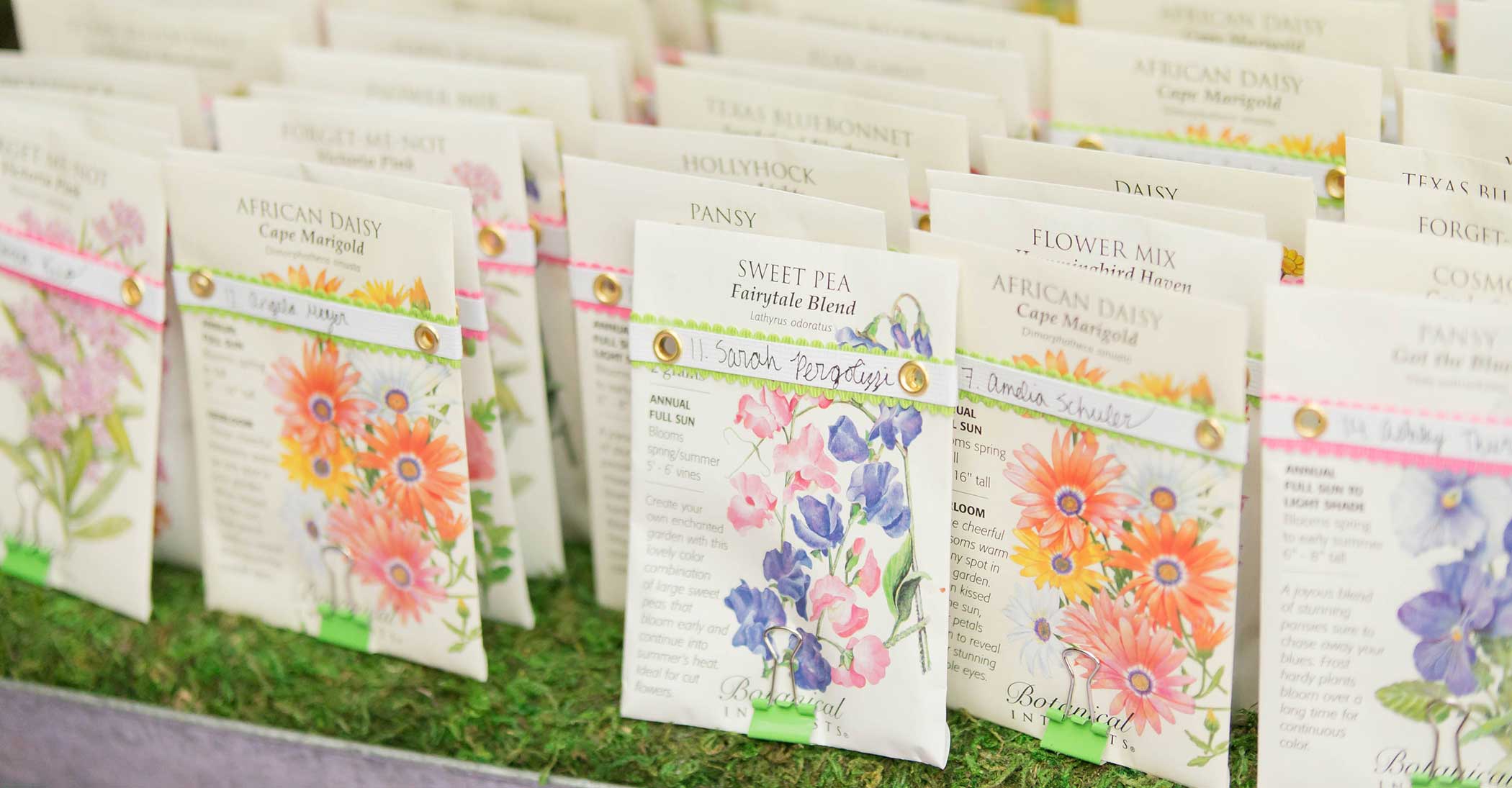
Photo © Leeann Marie Photography
When registering for gifts and picking out wedding favors, green is the way to go! Choosing organic or natural gifts will leave you and your guests with fond memories and beautiful keepsakes. Plus, it will reduce the amount of waste going to landfills after the event.

Gifts are an expression of love and appreciation, and weddings are the perfect event to showcase some inspirational green gift-giving. Eco-friendly favors can include things like potted succulents, crafts by local artisans and packets of native flower seeds — to keep the love blooming, of course! Eco-friendly household items on the registry can also be a great way to green up the home. Alternatively, when my husband and I were married, we asked our guests to donate to their favorite organizations in honor of our special day. It felt like our guests were spreading our joy across the city!
— Dr. Maria Wheeler-Dubas, Science Education Outreach Manager
Steps You Can Take
- Sow a Seed. Choose natural favors, such as seed packets, potted succulents or flowers. Plants make beautiful and useful gifts that clean the air, add style to a space and can even add fresh flavor to a home-cooked meal! Your guests will enjoy memories of your special day for years to come, and no packaging will go to waste.
- Register Responsibly. Choose eco-friendly items for your gift registry. Include items that will help to continue your sustainable lifestyle after you say “I do” — you may even inspire your guests to purchase similar products.
- Give Back.In lieu of gifts, have your guests choose a charity that they will donate to in honor of your special day. Ask guests to write a brief note about why the charity they choose matters to them, and it will create a do-good, feel-good impact.
Dig Deeper
Find ideas for perfect wedding gifts, great charities and environmentally friendly guest favors:
Eco-Friendly Wedding Gifts for the Green Couple | Martha Stewart Weddings
Eco-Friendly Favors | Martha Stewart Weddings
Charities in Pittsburgh, PA | Charity Navigator
Eco-Friendly Wedding Gifts | Green Living
10 Wedding Gifts for Eco-Conscious Newlyweds | Sierra Club
Nonprofits in Pittsburgh, PA | Great Nonprofits
Leaderboards | Give Big Pittsburgh
Eco-Friendly Wedding Registry: Everything You Should Ask For | Brides
Fabulous Eco-Friendly Favors that Never Go Out of Style | Bridal Guide
6. D.I.Y. Your Day
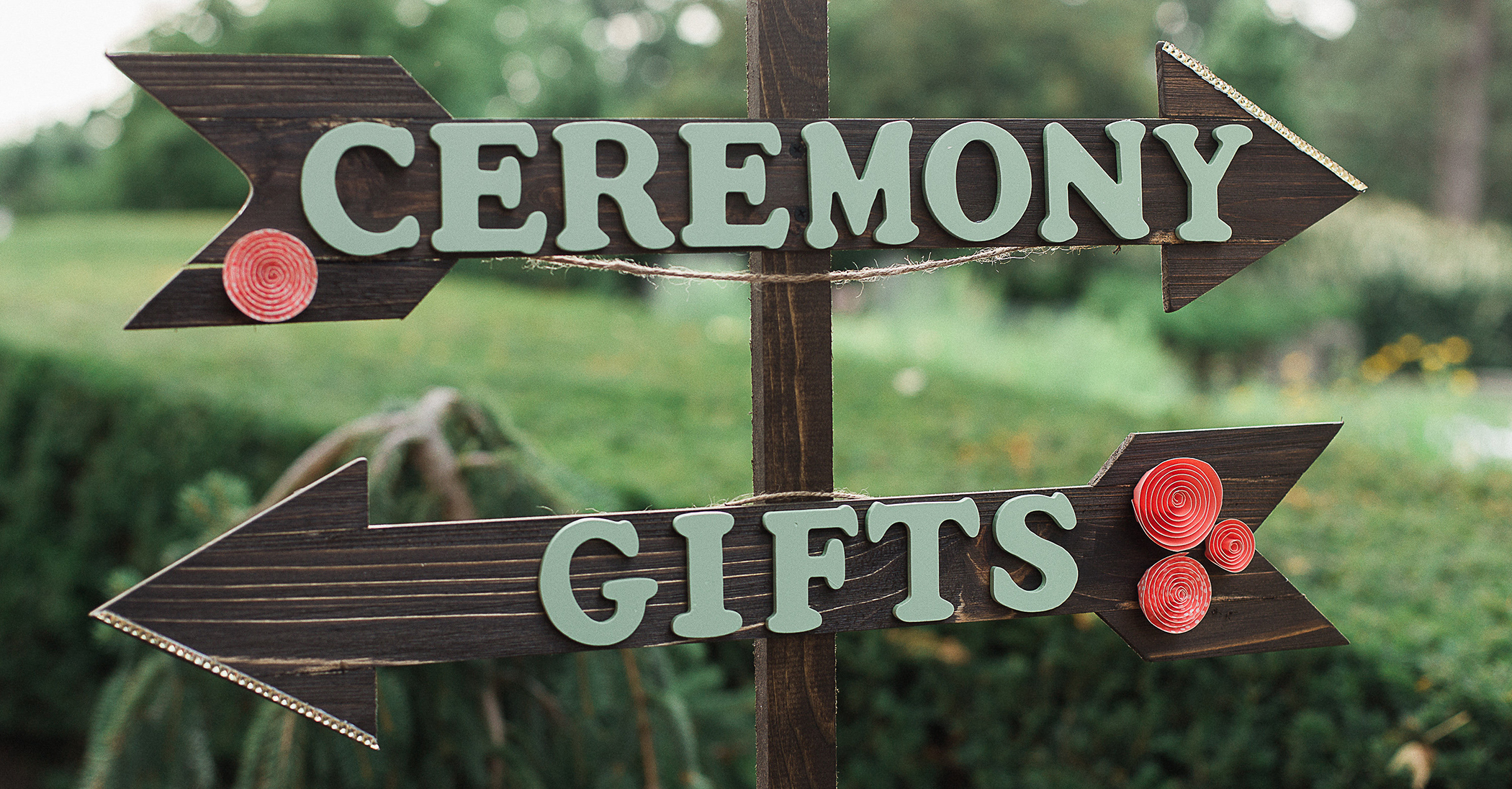
Photo © Breanna Elizabeth Photography
Give your wedding a unique flair by incorporating fancy finds, vintage fashion and do-it-yourself décor. Whatever your aesthetic, there are many online and local sellers who can help you discover statement pieces that will make your wedding stand out while showcasing your creativity and reducing its cost and carbon footprint.

When I think of weddings, I think of the beauty of two people sharing their lives with each other and uniting with a new purpose. Similarly, incorporating D.I.Y. décor by using recycled materials or looking to your backyard for natural materials is a way of giving everyday items a new purpose! Not confident in your own D.I.Y. abilities? Buying lightly used décor through The Wedding Flea Market and shopping at second-hand stores to find one-of-a-kind vintage pieces are other great options! From making your own center pieces to buying from local small businesses, there are many D.I.Y. options to help you reduce your carbon footprint and make fun memories with family and friends who help along the way, all while giving your wedding day a unique personal touch!
— Ashley Dean, Chief of Staff
Steps You Can Take
- Look for Hidden Treasures. Search thrift stores or flea markets for items that you can transform into one-of-a-kind centerpieces and décor. Need inspiration? A quick Google search or a glance at Pinterest yields a bounty of creative, easy and fun ideas. Enlist the help of your wedding party to accelerate the work flow while providing a way to spend extra time with the people who will be with you on your big day.
- Use Your Connections. Has a friend or relative gotten married recently? Did you like their style? If so, ask to borrow some of their pieces to use in your own celebration.
- Play for Keeps. Create or choose décor items that fit in with the style of your home so you can liven up your space with pretty pieces that hold special memories for you. Alternatively, pass your décor along to another bride-to-be, or find a new home for it on a wedding flea market or recycling site.
- Lease Your Look. There are plenty of beautiful and affordable rental options online that will give you the exact look you want while saving your bridesmaids and groomsmen a pretty penny and reducing your environmental impact.
- Turn Something Old Into Something New. Altering a family member’s bridal gown is a fun way to incorporate their memories into your special day while still expressing your own unique flair. Alternatively, shop for a vintage dress for a timeless look that will conserve your budget and help the planet.
Dig Deeper
Spark your creativity with these D.I.Y. décor ideas formalwear rental resources and more:
Wedding Flea Market
24 Eco-Friendly, D.I.Y. Wedding Ideas | CustomMade
Where to Buy and Sell Used Wedding Décor Online | Budget Savvy Bride
How to Set Up Your Own D.I.Y. Photo Booth | HGTV
5 Places to Find Bridesmaid Dresses for Rent | My Wedding
9 Secrets to Shopping for Vintage Wedding Dresses | Martha Stewart Weddings
The 8 Best Places to Buy Vintage Wedding Dresses | Who What Wear
Best Places to Rent a Tux in Pittsburgh | KDKA CBS Pittsburgh
9 Creative Ways to Use Potted Plants in Your Wedding | The Knot
How to Reuse Your Mom’s Wedding Dress | Fustany
35 Swoon-Worthy Centerpieces for Any Season | DIY Network
7. Buy Better Bouquets
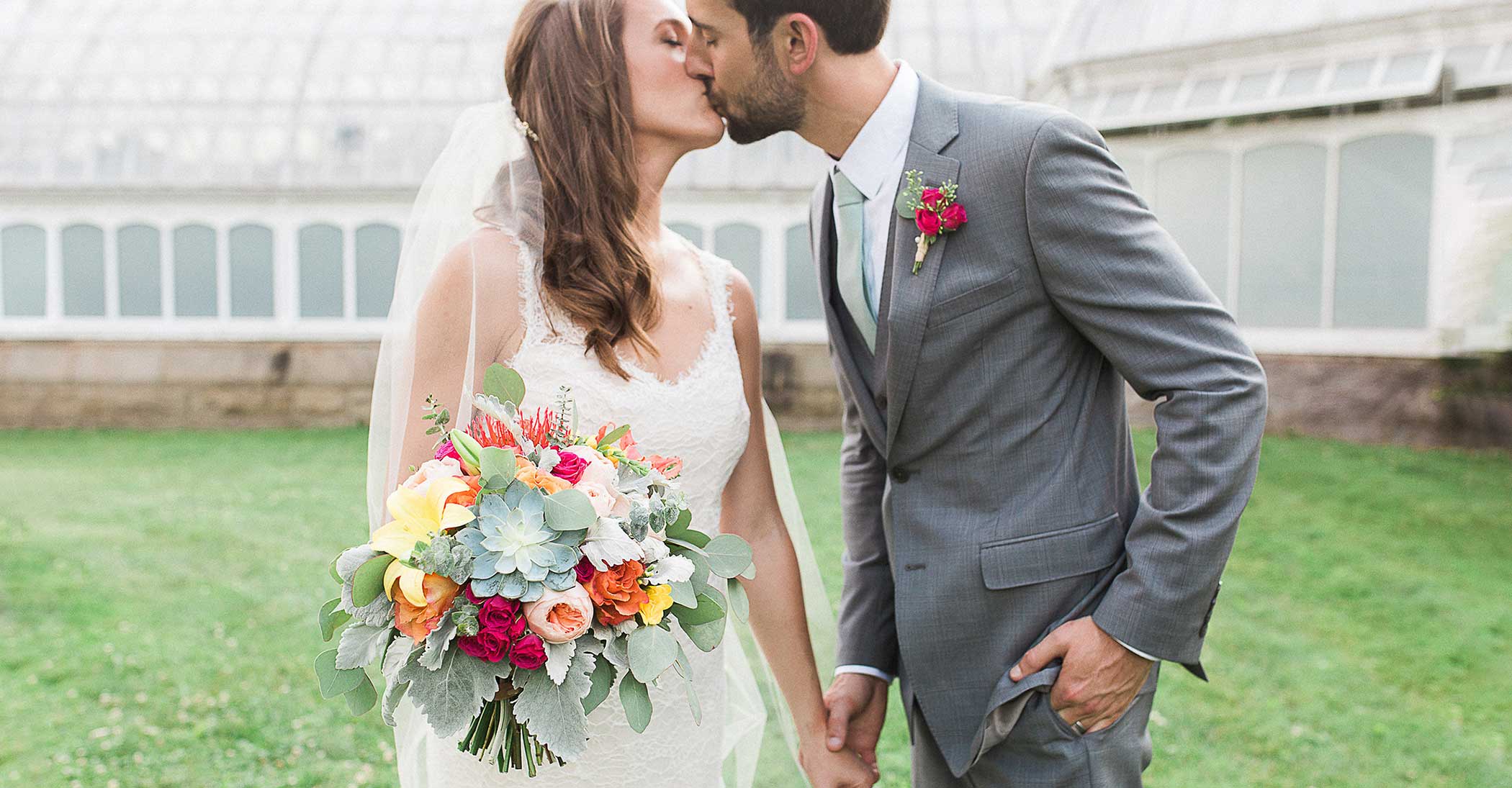
Photo © Breanna Elizabeth Photography
Incorporate nature’s most vibrant colors into your wedding by selecting in-season, locally grown flowers and other plant material for your bouquet. When the big event is over, spread your love by sending bouquets home with guests or donating them to a local senior citizen home.

Flowers play a huge role in a wedding. From the bride’s bouquet to the centerpieces on the table, memories are richer when the flowers look great. Freshness is key and when communicating with your florist, be aware that nothing is fresher than flowers in season sourced locally. Dried flowers and botanical elements look great too when added to fresh flowers, making wonderful accents to seasonal blooms. Flowers grown organically are preferred, but when you’re unable to locally source your flowers, look for fair trade certification to ensure farmers are providing fair wages for employees and are abiding by environmentally conscience practices.
— Ben Dunigan, Director of Horticulture and Education
Steps You Can Take
- Get to Know Your Grower. Find a responsible florist and inquire about their sourcing. Choose blooms that are in season and grown locally, organically and without pesticides. You will get fresher flowers while supporting local businesses and reducing carbon emissions from transportation. GreenSinner is one of Phipps’ trusted vendors that produces beautiful arrangements in an eco-conscious way.
- Pass It On. There are plenty of people who would love to give your beautiful bouquets a new home after the wedding. Offer them as favors to your guests or donate them to a nursing home or hospital. Any remaining flowers can go into your compost pile.
- Become Your Own Florist. Take a class to learn how to arrange flowers and connect with local growers. Then showcase your creativity by designing your bouquets by hand. Phipps offers floral design classes for people of all levels of experience.
- Toss the Bouquet. There are many alternatives to traditional bouquets that are beautiful and will make your wedding photos stand out in a crowd. Make or buy look-a-like flowers using paper or silk, carry an arrangement of foliage or go rustic with a decorated wreath.
Dig Deeper
Find local growers, learn about the impacts of pesticides, discover creative alternatives and explore Phipps’ floral design classes:
About Us | GreenSinner
Find Local Flowers | Local Flowers
Pesticides and Cut Flowers | The National Wildlife Federation
10 Beautiful and Creative Alternatives to Traditional Bridesmaid Bouquets | Chic Vintage Brides
Wedding Flower Alternatives | Budget Savvy Bride
Floral Design Classes | Phipps Conservatory and Botanical Gardens
8. Put a Responsible Ring On It
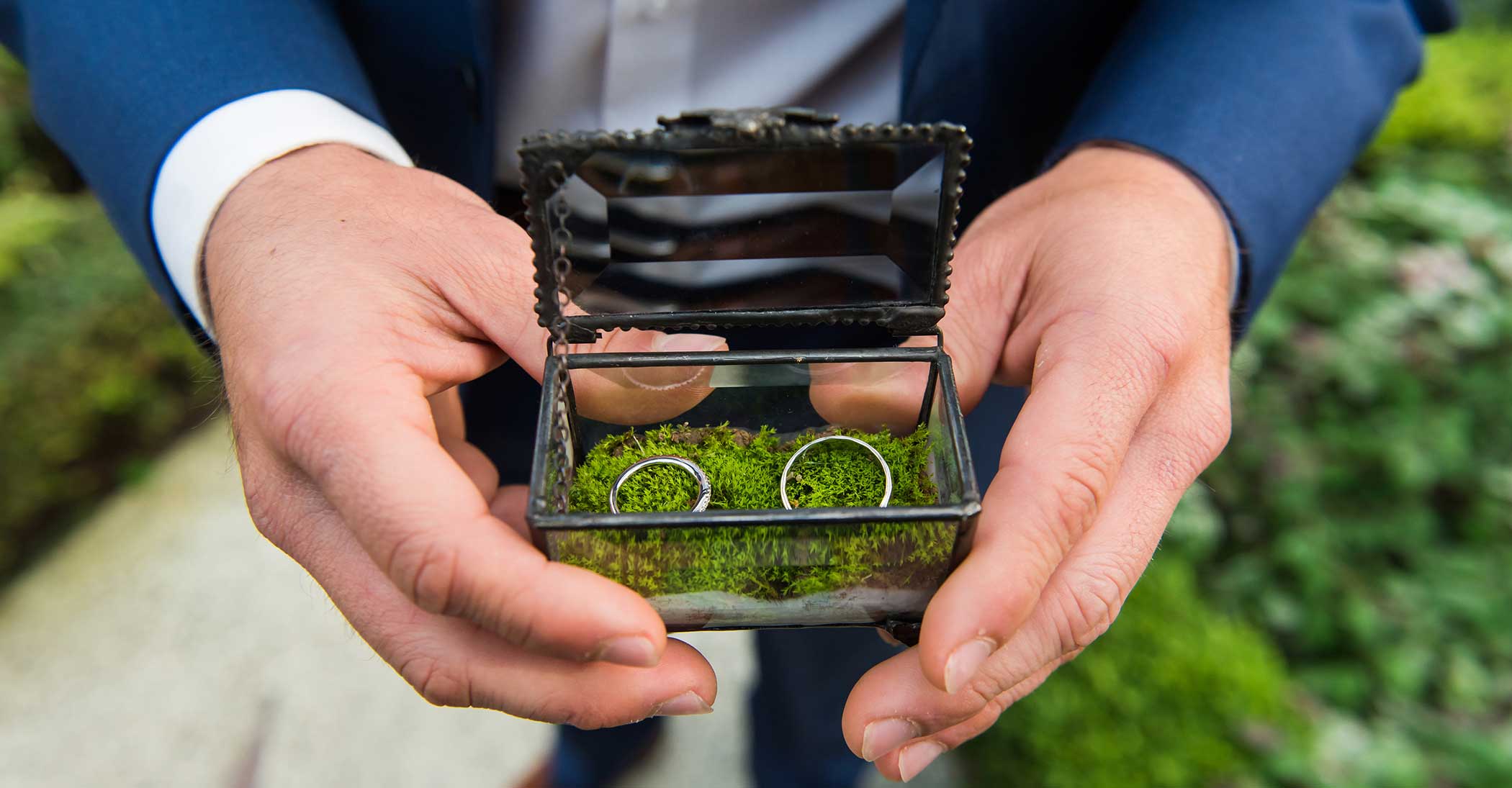
Photo © Leeann Marie Photography
Your engagement and wedding rings are beautiful representations of your love that you’ll wear for the rest of your life — it’s no wonder you want a gem that is unique to you. Rings that are responsibly sourced make for a beautiful choice that you can feel good about.

When you’re on the hunt for an engagement ring, a great way to narrow down your search at the beginning is by looking for a ring that has been ethically sourced. Ethically sourced engagement rings are luckily becoming much easier to find in today’s market, and with a much lower environmental impact than the mined diamond industry you can rest easy knowing you chose a responsible option. Cultured gemstones (lab-grown as opposed to mined) are the perfect stone choice as they are eligible to be certified by the International Gemological Institute, are sold at a lower price point than mined stones and are often even more brilliant than their mined counterparts. Many retailers today offer extensive amounts of information when it comes to lab-grown stones (Clean Origin has a great introduction to lab-grown diamonds) so they make it easy for you to find the perfect ring while staying environmentally conscious!
— Kelly Donaldson, Retail Manager
Steps You Can Take
- Choose a Responsible Rock. If your heart is set on a diamond, ask your jeweler about the source and origin of their gems. If they can’t tell you how they got from mine to market, keep shopping.
- Gold, Schmold! Consider nontraditional materials, such as palladium instead of gold, or alexandrite or morganite in place of a diamond. You’ll reduce your environmental impact and stand out from the crowd.
- Go Vintage. There are plenty of beautiful options at local jewelers or online retailers. New-to-you bling is eco-friendly, unique and almost always less expensive than a brand new ring.
Dig Deeper
Read up on the complete cost of engagement rings and more tips for choosing an environmentally friendly one:
How to Buy an Ethical Diamond | TIME
Are Your Rings Earth-Friendly and Conflict-Free? | The Knot
12 Ethical and Conflict-Free Engagement Rings for the Socially Conscious Bride-to-Be | The Good Trade
Vintage Engagement Rings for the Unconventional Bride | Refinery 29
11 Tips for Finding a Vintage Engagement Ring You’ll Cherish | Martha Stewart Weddings
Everything You Need to Know About Buying a Vintage Engagement Ring | Harper’s Bazaar
The True Cost of Your Engagement Ring | Green Biz
Catbird
About Us | Do Amore
9. Travel in Packs

Photo © Steven Dray Photography
Family and friends will travel across the globe to be with you on your wedding day. Once everyone is in the same city, a little coordination will reduce your party’s carbon footprint and provide more time for everyone to make memories together.

When planning your wedding, try keeping the events as local as possible. This will minimize the amount of travel that is needed. Sourcing catering and wedding flowers locally will also cut down on supply mileage that has an environmental impact. Providing guests with shuttle service is a great way to reduce carbon emissions. Especially, if you plan on having a large group of guests. Everyone will save money plus no guests will have to worry about driving post-wedding. If a shuttle service is not available for your wedding, Rideshare is a great alternative. These services allow passengers the option to save up to 20% on their ride while also being more climate-friendly. There are so many ways to travel more sustainably and still have time to celebrate with your loved one!
— Sahara Duncan, Event Sales Supervisor
Steps You Can Take
- Do the Shuttle Shuffle. Arrange shuttles or buses to minimize fossil fuel emissions and maximize wedding bonding time. Your guests will appreciate handing over the wheel, especially if they are unfamiliar with the area or plan on enjoying a cocktail or two at the reception.
- Hitch a Ride. Encourage guests to take an eco-friendly form of transportation to the wedding. Suggest that families or neighbors carpool in a fuel efficient vehicle — they can even make a fun road trip out of the occasion if they are traveling long distances or make arrangements to stay within walking distance of your wedding venue.
- Keep It Together. Opt to have the ceremony and reception in the same location or within walking distance of one another. You’ll spend more time reveling and less time traveling. Plus, your planning process will be easier and less expensive.
Dig Deeper
Use these resources to understand your wedding party’s impact on the environment and choose a transportation service that’s right for you:
Transportation in Pittsburgh, PA | The Knot
Alternative Vehicles and Ride Sharing in Pittsburgh | Pittsburgh Earth Day
For Commuters | Commute Info
Greenhouse Gas Equivalencies Calculator | United States Environmental Protection Agency
10. Find Your Honeymoon Habitat

Photo © Darien and Neil
It’s clear you appreciate the value of the natural world — when planning your honeymoon, consider taking an unforgettable trip to experience some of our planet’s natural wonders. There are plenty of smart options to choose from when it comes to accommodations and activities so you can enjoy a memorable vacation with your partner in life.

Planning a wedding can be daunting, especially an eco-friendly wedding, so it’s understandable that choosing an equally eco-friendly honeymoon spot may seem challenging as well. However, there are many ways to make sure your trip has a positive impact! No matter where you choose to go, the most important thing you can do is make sure you’re interacting with your surroundings in a healthy way. When traveling for a honeymoon, try to frequent locally owned spots and cater to small businesses. You can also find activities that are healthy for the planet. For example, instead of staying by the hotel pool all day, take a guided nature walk where you can learn about the natural ecosystem and local culture!
— Lauren Ranalli, Event Sales Supervisor
Steps You Can Take
- Explore a Local Oasis. Cut your carbon emissions by choosing a honeymoon location that you can access by car or train rather than flying. No matter where you live, a hidden paradise is likely not far away.
- LEED Your Lodging If you’re staying at a hotel, make sure they have green certifications. There are many LEED-certified hotels that make their environmental impact a top priority.
- Choose Your Adventure. It’s a given that you’ll want to fill your days with fun experiences. Consider tailoring your plans to be as environmentally sound as possible — for example, if you want to spend time in the water, choose kayaks or paddleboarding over Jet Skis.
- Go Wild. If you find an animal-related activity you would like to try, do a little research to learn about the animals’ welfare before booking your visit. Opt for experiences that allow you to observe the animals in their natural habitats from a safe distance, like whale watching or a safari rather than taking a photo with a trained dolphin. The best way to experience wildlife, after all, is in the wild.
- Enjoy the Cuisine Scene. Buy food from nearby markets or visit local restaurants so you can support the viability and economy of the place you’re staying. Eating local is also a great way to try new foods and truly immerse yourself in a different culture.
- Be Souvenir-Savvy. Choose your keepsakes carefully and buy from vendors that are transparent about the sourcing of their materials — you can make a big difference for the welfare of local animal and plant life just by doing a little research! Purchasing from local artisans is a good place to start and supports your destination's economy.
- Take a Hike. Try your best to walk or take public transportation whenever possible. If you’re in a city, explore your options when it comes to buses, subways, taxis or even ride-sharing. If you travel on foot, you’ll find that walking is one of the best ways to immerse yourself in a place, go off the beaten path and create memorable experiences. It's the healthiest way to travel, too!
- Set It Off. Terrapass allows you to calculate the amount of emissions you create and gives you the opportunity to purchase carbon offsets so you can have a guilt-free vacation and give back!
Dig Deeper
For more in-depth guides and honeymoon ideas, refer to the sources below:
Designing an Eco-Friendly Honeymoon | The New York Times
Best Places to Get Face-to-Face with Wildlife | National Geographic
Plan Your Visit | National Park Service
Eco-Friendly Advice on Vacation Souvenirs | Ethical Traveler
Purchase Offsets | Terrapass
Wedding List | Carbon Footprint
10 Tough Questions to Ask Hotels | It Must Be Now
Green Vacations: 10 Places That Don’t Cost the Earth | CNN Travel
Hotels Worldwide Are Going Green with LEED | U.S. Green Building Council
